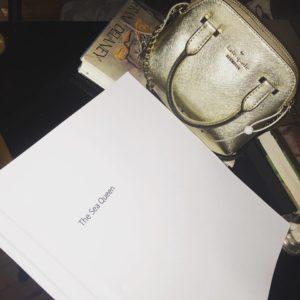 On Friday morning, I decided that, at 110,000 words, and about 80% of the chapters written, it was time to go back to the beginning of my rough draft of THE SEA QUEEN, the sequel to THE HALF-DROWNED KING. I’m a big believer in working straight forward on the first draft of a novel, using a rough outline. If I run into a snag where I realize I need to set something up that I didn’t, I usually make notes about it, write down some To Dos to handle in the next draft, and keep moving forward.
On Friday morning, I decided that, at 110,000 words, and about 80% of the chapters written, it was time to go back to the beginning of my rough draft of THE SEA QUEEN, the sequel to THE HALF-DROWNED KING. I’m a big believer in working straight forward on the first draft of a novel, using a rough outline. If I run into a snag where I realize I need to set something up that I didn’t, I usually make notes about it, write down some To Dos to handle in the next draft, and keep moving forward.
Eventually that stops working, though. In the last few chapters of a novel, all of the threads need to come together. The details that I’ve been putting off for later become too important to ignore. For instance, this book contains a blood feud between some secondary characters which needs to erupt out into the main story-line in the last five chapters. I have some pieces of that feud written, but not enough to know where all the players are when it all comes to a head, and in order to write the last pieces, I need to know those details.
Also, when I’m writing a rough draft, I tend to skimp on description in favor of dialogue and action. It’s necessary to keep moving at a good pace, but it grows tedious for me. I love writing description–good description reveals character, sets a mood, and plants thematic seeds that can develop later in the novel. I’m missing most of that right now, and therefore missing a lot of the fun of writing.
Any writing process, including banging out a rough draft as quickly as possible, should be used in the service of getting the thing written, polished, and ready to be seen by others. So while discipline is important, so is deviating from the process when it ceases to be useful.
I’ve also found this to be a pattern with my writing now–this is my third “completed” rough draft, and with each one, I’ve felt compelled to start re-writing from the beginning when I finish 70-80% of the total planned chapters.
A rough draft is all potential, sometimes a bit too much. A first editing pass can be even more exciting, though, with its balance of constraint and freedom. For instance, in the current draft, my first chapter is from the point of view of a less compelling character. I played with the idea of changing the POV, but I can also choose to make this character an interesting person. It is more work, but probably the right call. It’s not too late to make those changes. On the other hand, I know the shape of the whole story, and most of the plots, subplots, and arcs, which I didn’t when starting the rough draft. This gives me a structure to work within.
At this point, at the beginning of turning the rough draft into a real first draft, I am doing the following things:
- Re-assessing each of the characters: summarizing their arcs, major plot points, and making sure I know the answers to these questions:
- What do they want?
- What stands in the way of getting what they want? What is their major malfunction?
- What is their character arc? Where do they start, where are they in the middle, and where do they end?
- What is the arc of their major relationships?
- Re-assessing each of the chapters, and making sure I know the answer to these questions:
- Who is in the chapter?
- What are the major beats or scenes?
- What is the central conflict?
- What decisions do the characters make in this chapter? Ideally, the POV character should be making at least one decision, or they probably shouldn’t be the POV character for that chapter.
- What is the chapter’s purpose for the plot?
- What is the chapter’s purpose for the characters?
- What is the chapter’s purpose for the theme?
This is the point at which I need to make sure I know the answers to those questions, rather than writing and seeing what happens. Sometimes I don’t know, and then I write about the problems longhand in a notebook, or I try writing a scene to see if it works, and if I like it, and feel like it’s working, make sure I know all of the necessary answers about it.
I predict this phase will take a couple of months. Then I will leave it alone for a month, and come back and do a final pass on it before showing it to anyone else. Or I will need to do more than one pass. I’m still learning this as I go along, but each time I do it, I know a little more, or at least I have more different ways to try solving a problem.